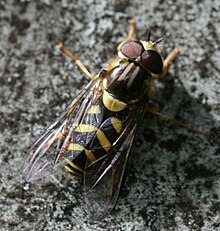| Dasysyrphus albostriatus | |
|---|---|

| |
| male | |

| |
| female | |
| Scientific classification | |
| Domain: | Eukaryota |
| Kingdom: | Animalia |
| Phylum: | Arthropoda |
| Class: | Insecta |
| Order: | Diptera |
| Family: | Syrphidae |
| Genus: | Dasysyrphus |
| Species: | D. albostriatus |
| Binomial name | |
| Dasysyrphus albostriatus (Fallén, 1817) | |
| Synonyms | |
Dasysyrphus albostriatus is a Palearctic species of hoverfly.
Description
External images
For terms see Morphology of Diptera
Wing length 6·25–9·5 mm. Thorax dorsum with two median stripes of white dust. The thorax is otherwise shining black. Tergites with linear yellow spots which sometimes connect on tergites 3 and 4.
The larva is figured by Dusek and Laska (1962).
Distribution
Palaearctic. Fennoscandia South to Iberia and north Africa. Ireland eastwards through Central and Southern Europe (Italy, Yugoslavia) to Greece, Turkey and European parts of Russia (South to Crimea and the Caucasus). East into Central Asia and Japan.

Biology
Habitat coniferous and deciduous woodland and conifer plantation, up to the alpine zone, tracksides, clearings, parks, gardens. Flowers visited include yellow composites, white umbellifers, Acer pseudoplatanus, Calluna, Crataegus, Euphorbia, Lonicera xylosteum, Papaver, Ranunculus, Rubus, Salix, Sorbus, Stellaria, Succisa pratensis, and Viburnum opulus. The flight period is from the end of April (early April in southern Europe) to September. The larva is predominantly aphid-feeding, but also predatory on a wide range of soft-bodied insects.
References
- Stubbs, Alan E.; Falk, Steven J. (1983). British Hoverflies: An Illustrated Identification Guide. British Entomological & Natural History Society. pp. 253, xvpp.
- Van Veen, M. (2004) Hoverflies of Northwest Europe: identification keys to the Syrphidae. 256pp. KNNV Publishing, Utrecht.addendum
- Van der Goot,V.S. (1981) De zweefvliegen van Noordwest - Europa en Europees Rusland, in het bijzonder van de Benelux. KNNV, Uitgave no.32: 275pp. Amsterdam.
- Bei-Bienko, G.Y. & Steyskal, G.C. (1988) Keys to the Insects of the European Part of the USSR, Volume V: Diptera and Siphonaptera, Part I. Amerind Publishing Co., New Delhi. ISBN 81-205-0080-6.
- Coe, R.L. (1953) Diptera: Syrphidae. Handbks.ident.Br.insects, 10(1): 1–98. R.ent.Soc.London. pdf Archived 2018-10-04 at the Wayback Machine
- Dusek, J. & Laska, P. (1962) Beitrag zur Kenntnis einiger Syrphiden-larven (Diptera, Syrphidae). Acta Soc. Ent. Cechosloveniae, 59: 348–356.
- Fauna Europaea
- Peck, L.V. (1988) Syrphidae. In: Soos, A. & Papp, L. (eds.) Catalogue of Palaearctic Diptera, 8: 11–230. Akad.Kiado, Budapest.
- Speight, M.C.D. (2011). "Species accounts of European Syrphidae (Diptera)" (PDF). Syrph the Net, the database of European Syrphidae. 65: 285pp.
- de Buck, N. (1990) Bloembezoek en bestuivingsecologie van Zweefvliegen (Diptera, Syrphidae) in het bijzonder voor België. Doc.Trav. IRSNB, no.60, 1–167.
| Taxon identifiers | |
|---|---|
| Dasysyrphus albostriatus | |
This hoverfly article is a stub. You can help Misplaced Pages by expanding it. |